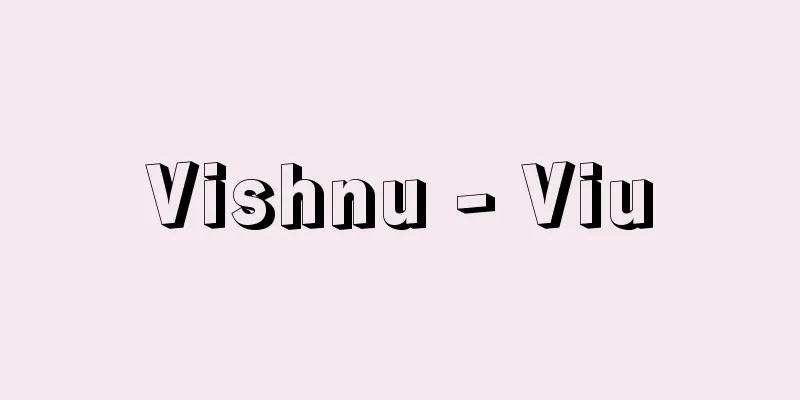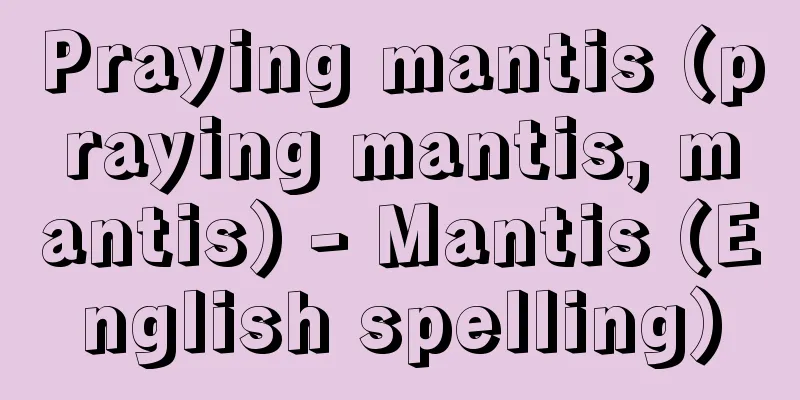Vishnu - Viu

|
One of the main gods of Hinduism. Vishnu already appeared in the Rig Veda, the oldest scripture in India, and was praised for striding across the three worlds of heaven, earth, and space in three steps. Originally, he was considered to be the personification of the sun's illuminating power, but was not a very important god at that time. However, as Hinduism became more popular, Vishnu, along with Shiva, became the main god of Hinduism and attracted the faith of the people. It is said that Brahma (Brahma) created the universe, Vishnu maintained it, and Shiva destroyed it. While Shiva is related to mountains, Vishnu is closely related to the ocean. In the beginning, he and the gods obtained amrita (nectar), the drink of immortality, from the bottom of the sea. In the process, he married Shri (Lakshmi, Kisshoten), who emerged from the sea, and wore a jewel that also emerged from the sea on his chest. He slept on the water using a giant snake (the dragon Shesha) as his bed, and Brahma emerged from a lotus flower that grew from Vishnu's navel. Vishnu is also said to wield a discus (chakra) and a club as weapons, and ride on a Garuda bird. In later times, the Vishnu mythology was refined, and Vishnu's incarnations, avatars, were listed. Usually, ten incarnations are listed: boar (Baraha), man-lion (Nrishimha), turtle (Kurma), dwarf (Bhamana), fish (Matsya), Rama, Parashurama, Krishna, Buddha, and Kalki. [Katsuhiko Uemura] [References] | | |Vijayanagar Empire (15th century) Bronze Height: 85.9 cm Tamil Nadu, India Collection of the Art Institute of Chicago Vishnu Source: Shogakukan Encyclopedia Nipponica About Encyclopedia Nipponica Information | Legend |
|
ヒンドゥー教の主神の一つ。ビシュヌはすでにインド最古の聖典『リグ・ベーダ』に登場し、天・空・地の三界を三歩で闊歩(かっぽ)するとたたえられた。元来、太陽の光照作用を神格化したものとみなされるが、この時期にはそれほど重要な神ではなかった。ところが、ヒンドゥー教が盛んになると、ビシュヌはシバ神とともに、ヒンドゥー教の主神として民衆の信仰を集めた。ブラフマー(梵天(ぼんてん))が宇宙を創造し、ビシュヌがそれを維持し、シバがそれを破壊するとされる。シバが山岳と関係あるのに対し、ビシュヌは海洋と縁が深い。太初、彼は神々とともに海底から不死の飲料アムリタ(甘露)を得た。その過程において、海中から出現したシュリー(ラクシュミー、吉祥天(きちじょうてん))を妻とし、やはり海中から生じた宝珠を胸にかける。彼は大蛇(シェーシャ竜)を寝台として水上で眠り、ブラフマーはビシュヌの臍(へそ)に生えた蓮華(れんげ)から現れたという。また、ビシュヌは武器として円盤(チャクラ)、棍棒(こんぼう)を持ち、ガルダ鳥に乗るとされる。後代になるとビシュヌ神話が整備されて、ビシュヌの化身avatāraが列挙されるようになる。通常、猪(いのしし)(バラーハ)、人獅子(しし)(ヌリシンハ)、亀(クールマ)、侏儒(しゅじゅ)(バーマナ)、魚(マツヤ)、ラーマ、パラシュラーマ、クリシュナ、ブッダ、カルキの10種の化身があげられる。 [上村勝彦] [参照項目] | | |ビジャヤナガル王国(15世紀) 青銅 高さ85.9cm インド タミル・ナド州シカゴ美術研究所所蔵"> ビシュヌ 出典 小学館 日本大百科全書(ニッポニカ)日本大百科全書(ニッポニカ)について 情報 | 凡例 |
<<: Vaishnava (English spelling) Vaiava
Recommend
Cymrus
...Determinate inflorescences often end with a fl...
Maidenhair tree - Maidenhair tree
→ Campanula Source: Shogakukan Encyclopedia Nippo...
Shiryo
Chinese female lawyer and politician. Born in Jia...
Bonang (English spelling)
An instrument used in Indonesian gamelan ensemble ...
hot-line
...The idea of crisis management became fully e...
suicide altruiste (English spelling)
…In his book “Suicide: An Essay on Sociology” (18...
Continuous underground wall
A continuous wall is constructed by excavating a w...
Transverse valley
Valleys that cross mountain ranges. When a river c...
Menace - Intimidation
〘noun〙① To threaten someone with force. Intimidati...
Hypoglycemia
Definition and Concept 1) Mechanism of increasing ...
Parent company/subsidiary company
When there is a relationship of control and subord...
hymn
...Christian hymn, derived from the Greek hymnos....
Early modern short poem style
... The early Edo period songs whose realities ca...
"Elegy of Adonis"
…Years of birth and death unknown. He composed pa...
xanthommatine
...A general term for pigment compounds derived f...









